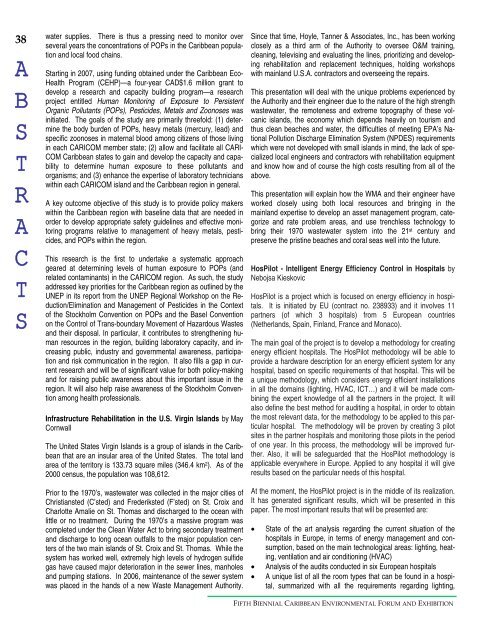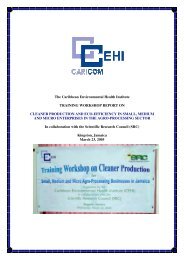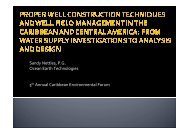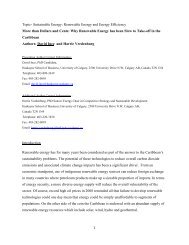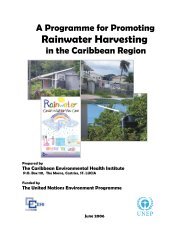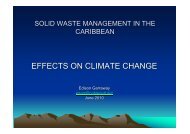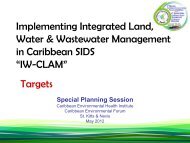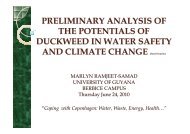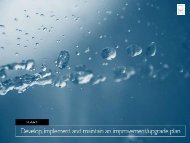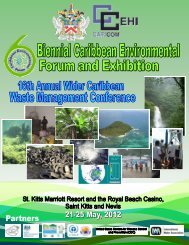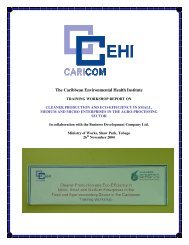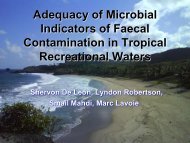conference magazine - Caribbean Environmental Health Institute
conference magazine - Caribbean Environmental Health Institute
conference magazine - Caribbean Environmental Health Institute
You also want an ePaper? Increase the reach of your titles
YUMPU automatically turns print PDFs into web optimized ePapers that Google loves.
38<br />
water supplies. There is thus a pressing need to monitor over<br />
several years the concentrations of POPs in the <strong>Caribbean</strong> population<br />
and local food chains.<br />
A<br />
B<br />
S<br />
T<br />
R<br />
A<br />
C<br />
T<br />
S<br />
Starting in 2007, using funding obtained under the <strong>Caribbean</strong> Eco-<br />
<strong>Health</strong> Program (CEHP)—a four-year CAD$1.6 million grant to<br />
develop a research and capacity building program—a research<br />
project entitled Human Monitoring of Exposure to Persistent<br />
Organic Pollutants (POPs), Pesticides, Metals and Zoonoses was<br />
initiated. The goals of the study are primarily threefold: (1) determine<br />
the body burden of POPs, heavy metals (mercury, lead) and<br />
specific zoonoses in maternal blood among citizens of those living<br />
in each CARICOM member state; (2) allow and facilitate all CARI-<br />
COM <strong>Caribbean</strong> states to gain and develop the capacity and capability<br />
to determine human exposure to these pollutants and<br />
organisms; and (3) enhance the expertise of laboratory technicians<br />
within each CARICOM island and the <strong>Caribbean</strong> region in general.<br />
A key outcome objective of this study is to provide policy makers<br />
within the <strong>Caribbean</strong> region with baseline data that are needed in<br />
order to develop appropriate safety guidelines and effective monitoring<br />
programs relative to management of heavy metals, pesticides,<br />
and POPs within the region.<br />
This research is the first to undertake a systematic approach<br />
geared at determining levels of human exposure to POPs (and<br />
related contaminants) in the CARICOM region. As such, the study<br />
addressed key priorities for the <strong>Caribbean</strong> region as outlined by the<br />
UNEP in its report from the UNEP Regional Workshop on the Reduction/Elimination<br />
and Management of Pesticides in the Context<br />
of the Stockholm Convention on POPs and the Basel Convention<br />
on the Control of Trans-boundary Movement of Hazardous Wastes<br />
and their disposal. In particular, it contributes to strengthening human<br />
resources in the region, building laboratory capacity, and increasing<br />
public, industry and governmental awareness, participation<br />
and risk communication in the region. It also fills a gap in current<br />
research and will be of significant value for both policy-making<br />
and for raising public awareness about this important issue in the<br />
region. It will also help raise awareness of the Stockholm Convention<br />
among health professionals.<br />
Infrastructure Rehabilitation in the U.S. Virgin Islands by May<br />
Cornwall<br />
The United States Virgin Islands is a group of islands in the <strong>Caribbean</strong><br />
that are an insular area of the United States. The total land<br />
area of the territory is 133.73 square miles (346.4 km 2 ). As of the<br />
2000 census, the population was 108,612.<br />
Prior to the 1970’s, wastewater was collected in the major cities of<br />
Christiansted (C’sted) and Frederiksted (F’sted) on St. Croix and<br />
Charlotte Amalie on St. Thomas and discharged to the ocean with<br />
little or no treatment. During the 1970’s a massive program was<br />
completed under the Clean Water Act to bring secondary treatment<br />
and discharge to long ocean outfalls to the major population centers<br />
of the two main islands of St. Croix and St. Thomas. While the<br />
system has worked well, extremely high levels of hydrogen sulfide<br />
gas have caused major deterioration in the sewer lines, manholes<br />
and pumping stations. In 2006, maintenance of the sewer system<br />
was placed in the hands of a new Waste Management Authority.<br />
Since that time, Hoyle, Tanner & Associates, Inc., has been working<br />
closely as a third arm of the Authority to oversee O&M training,<br />
cleaning, televising and evaluating the lines, prioritizing and developing<br />
rehabilitation and replacement techniques, holding workshops<br />
with mainland U.S.A. contractors and overseeing the repairs.<br />
This presentation will deal with the unique problems experienced by<br />
the Authority and their engineer due to the nature of the high strength<br />
wastewater, the remoteness and extreme topography of these volcanic<br />
islands, the economy which depends heavily on tourism and<br />
thus clean beaches and water, the difficulties of meeting EPA’s National<br />
Pollution Discharge Elimination System (NPDES) requirements<br />
which were not developed with small islands in mind, the lack of specialized<br />
local engineers and contractors with rehabilitation equipment<br />
and know how and of course the high costs resulting from all of the<br />
above.<br />
This presentation will explain how the WMA and their engineer have<br />
worked closely using both local resources and bringing in the<br />
mainland expertise to develop an asset management program, categorize<br />
and rate problem areas, and use trenchless technology to<br />
bring their 1970 wastewater system into the 21 st century and<br />
preserve the pristine beaches and coral seas well into the future.<br />
HosPilot - Intelligent Energy Efficiency Control in Hospitals by<br />
Nebojsa Kieskovic<br />
HosPilot is a project which is focused on energy efficiency in hospitals.<br />
It is initiated by EU (contract no. 238933) and it involves 11<br />
partners (of which 3 hospitals) from 5 European countries<br />
(Netherlands, Spain, Finland, France and Monaco).<br />
The main goal of the project is to develop a methodology for creating<br />
energy efficient hospitals. The HosPilot methodology will be able to<br />
provide a hardware description for an energy efficient system for any<br />
hospital, based on specific requirements of that hospital. This will be<br />
a unique methodology, which considers energy efficient installations<br />
in all the domains (lighting, HVAC, ICT…) and it will be made combining<br />
the expert knowledge of all the partners in the project. It will<br />
also define the best method for auditing a hospital, in order to obtain<br />
the most relevant data, for the methodology to be applied to this particular<br />
hospital. The methodology will be proven by creating 3 pilot<br />
sites in the partner hospitals and monitoring those pilots in the period<br />
of one year. In this process, the methodology will be improved further.<br />
Also, it will be safeguarded that the HosPilot methodology is<br />
applicable everywhere in Europe. Applied to any hospital it will give<br />
results based on the particular needs of this hospital.<br />
At the moment, the HosPilot project is in the middle of its realization.<br />
It has generated significant results, which will be presented in this<br />
paper. The most important results that will be presented are:<br />
• State of the art analysis regarding the current situation of the<br />
hospitals in Europe, in terms of energy management and consumption,<br />
based on the main technological areas: lighting, heating,<br />
ventilation and air conditioning (HVAC)<br />
• Analysis of the audits conducted in six European hospitals<br />
• A unique list of all the room types that can be found in a hospital,<br />
summarized with all the requirements regarding lighting,<br />
FIFTH BIENNIAL CARIBBEAN ENVIRONMENTAL FORUM AND EXHIBITION


